|
MAY 2019

|
On
the first Memorial Day after World War I, Hicksville
schoolchildren laid wreaths at three saplings, planted in memory
of the local men who had died in the conflict: Sgt. Joseph A.
Barry, Pvt. Charles A. Wagner, and Cpl. Walter S. Wheeler.
No one in the village visited the
men's graves that day, for they lay buried in
France
.
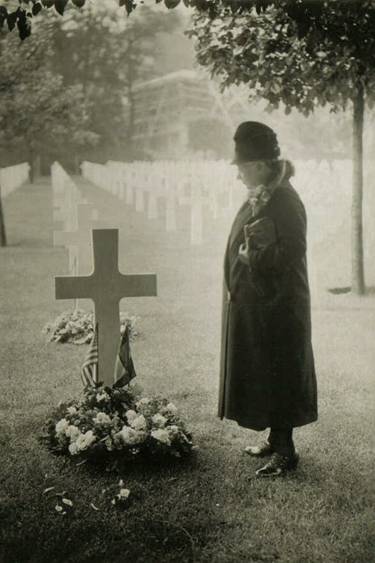
Gold
Star Mother Ellen Barry stands at the grave of her son Joseph.
Plot A Row 1 Grave 29, Suresnes American Cemetery, Suresnes,
France
Photo courtesy of Barry family relative C.E.B. Howard
|
***
Prelude
Joseph and Maria Wagner emigrated from
Austria
in the 1890s. They first
settled in
New Jersey
, where their son Charles was born, and afterward moved to
Division Avenue
in
Hicksville
. Charles later became a
plumber.
He enlisted in the Army only a few weeks after the nation entered
the Great War in 1917.
|

|

|
|
Huntington
Long-Islander
|
Pvt.
Charles A. Wagner
Find-A-Grave.com
|
*
Already
a young man, Joseph Barry moved to Hicksville from the
Bronx
, as part of his Irish-born parents' family.
The Barrys first resided on
William Street
, and later moved to
Harrison Avenue
. In 1915, like his father,
he worked as a plumber, but by the 1917 draft registration he was
working as a "chauffer" for Nassau Lumber.
Drafted,
Joe was inducted into the Army on May 29, 1918.
His younger brother Edmund was already serving in the Navy.
|

|
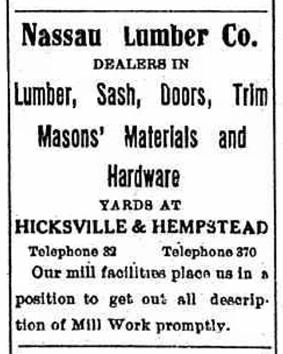
|
|
Sgt.
Joseph A. Barry
Photo courtesy of C.E.B. Howard
|
Huntington
Long-Islander
|
*
Samuel and Mary Wheeler also moved their family from
the Bronx to
Hicksville
, where they resided on
Cherry Street
near
Division Avenue
. Samuel managed
Tucker Electrical's Hicksville branch, at which their son Walter
worked as an electrician; Walter likely helped wire the new
Huettner
Building
that opened late in 1918. He
also was a member of the Hicksville Fire Department.
|

|
|
Look at that
Hicksville
Telephone number!
Huntington
Long-Islander
|
|
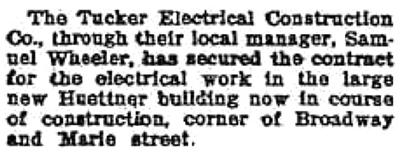
|
|
Huntington
Long-Islander
|
Like
Joseph Barry, Walter Wheeler was inducted as a draftee into the Army on
May 29, 1918.
***
Civilians
Become Soldiers
First
Steps (HUP-two-three-four...)
After declaring war,
America
built sixteen "cantonments" at which nearly four million draftees
would start their Army service. The
LIRR took men by the
thousands, including Joseph Barry and Walter Wheeler, to the cantonment
at Yaphank.
|
Camp
Upton

Train-top
view of draftees arriving at
Camp
Upton
;
the LIRR carried 20% of the country's military rail passengers
during the war
With
a capacity of 18,000,
Upton
was not the largest new camp, but it may have been the busiest.
It did more than process human tsunamis of draftees.
When inland regiments came east, bound for
France
, many stayed at
Upton
pending assignment to ships - often waiting days for troop
ships to arrive in
New York
Harbor
in sufficient number to form convoys.
Between
1917 and 1919,
Upton
was served by more than 4,000 LIRR trains, which carried
4,400,000 passengers and delivered 500,000 tons of supplies.
All those trains, people, and supplies rumbled through
Hicksville
. The men who
operated the town's crossing gates never got a chance to rest.
|
Some draftees from each
train proved unsuitable (e.g., anarchists, the mentally incompetent, and
immigrants who refused to profess loyalty to the
U.S.
) and were sent home. Those
who remained were inducted into the Army and got uniforms, bunks, food,
and perfunctory training. Most
would not remain in Yaphank for their real training - greater
New York
had too many draftees to fit into any one camp.
Instead, they would be scattered around the country to other Army
posts.
*
After enlisting, Charles
Wagner found himself in
Waco
,
Texas
at
Camp
MacArthur
, where many of its 43,000 soldiers lived in a city of wooden-floored
tents.

Tents at
Camp
MacArthur
didn't offer much comfort
when winter blizzards swept across
Texas
.
blogs.baylor.edu/texascollection/category/waco/camp-macarthur/
Just seventeen days after they arrived
at
Camp
Upton
, James Barry and Walter Wheeler boarded an outbound troop train, soon
watched Hicksville speed past, and were on their way to
Jacksonville
,
Florida
and Camp Joseph E. Johnston.
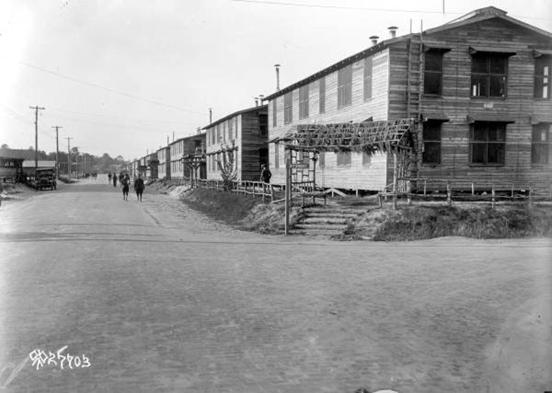
Barracks
at
Camp
Joseph
E.
Johnston
worldwar1centennial.org/index.php/261-florida.html
In their camps, in
addition to normal Army training, soldiers also received further wartime
instruction: they were taught basic French.
Whether on streets or battlefields, they would need to make
themselves understood.
*
Many
Kinds of Soldiers
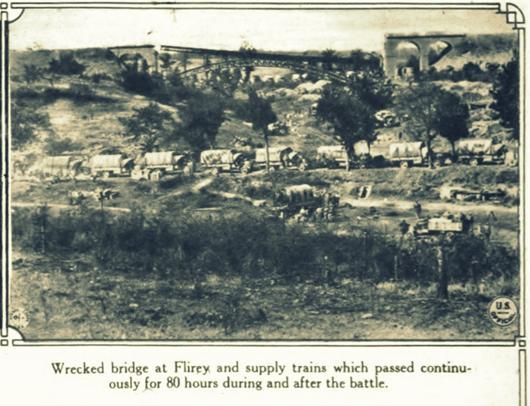
raycityhistory.wordpress.com/tag/st-mihiel-offensive/
There was more to a fighting army than
infantry and artillery. It
needed men to do a variety of critical jobs, and the Army decided which
man would do which job. And
so, it happened that soldiers Barry, Wagner, and Wheeler all were
allocated to Transport units of the U.S.Q.M.C. (Quartermaster Corps).
Let's look at how such men served their country in the war.
***
Men
+ Horses + Trucks = Trains
Supply
Trains
It was a challenge to stretch the
Army's supply lines across the
Atlantic
, as well as across the country, in order to sustain 4,000,000 soldiers.
To bring the supplies to the fight, once in
France
the Corps would need men to organize supply depots, keep trucks running,
keep horses shod, drive wagons or trucks, and load and unload supplies
- and all of them might have to do their jobs while under enemy fire.
In order to keep a Regiment constantly prepared for combat, the
U.S.Q.M.C. provided it with one or more "Supply Trains."
This was equivalent to the Regiment's having its own FedEx
operation(s), complete with vehicles, a warehouse or two, and personnel.
Supply Trains acquired and stocked everything their
"customers" required: food, cooking utensils, shoelaces, gas masks,
etc. Deliveries were made
wherever and whenever supplies were needed.
Usually, medical supplies and ammunition were handled by
special-purpose Trains (e.g., Charles Wagner served in an "Ammunition
Train").
*
Horses
vs. Trucks
This war would test the Quartermaster
Corps. Teams of horses -
its traditional way of moving supplies - could pull loaded wagons only
about eight muddy miles. With
enemy artillery reaching further than before, many supply depots would
have to be located further than eight miles from combat.

Motor power and horse power move side-by-side.
That's NOT a Mercedes logo on the left; it's the French-built
truck's Solex radiator.
2nd-division.com
Army "brass" was skeptical about relying on motor trucks
instead of animals. High-capacity
trucks were new and unproved. They
required spare parts, gasoline, and mechanics, and they could not go
off-road as easily as horses. Not
fully confident in either animals or trucks, the Army used both during
the war.
|
One
Truck to Rule Them All?
No one manufacturer
could build enough heavy-duty trucks for the entire Army, so the
U.S.Q.M.C. bought a variety of them, trained its mechanics to
fix each variety, and bought spare parts for all of them.
Such diversity was a liability, as wartime maintenance
would be frequent.
To resolve this issue, the U.S.Q.M.C. worked with a group of
manufacturers to design a standard truck, which could be built
by multiple corporations using identical critical parts.
For example, a defective radiator (or even an entire
engine) in a truck could be replaced by a similar component
produced by any of the manufacturers.
Eventually, orders were placed for over 52,000 such trucks.
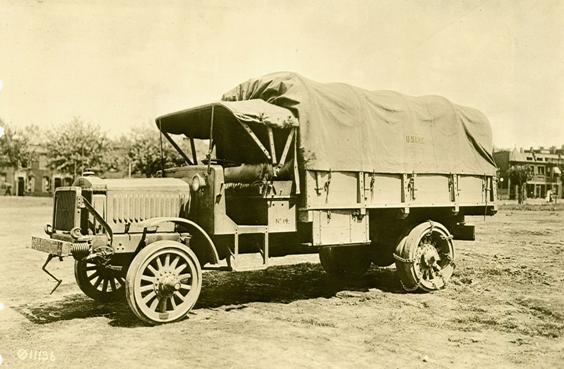
First-series
Liberty
Truck; "U.S.Q.M.C." can be seen
stenciled
on the tarp
Wikipedia
Dubbed "Liberty
Trucks," the vehicles seemed to work well, but none reached
France
until October 1918, and almost none served in the war.
At war's end, the more than 40,000 orders still
outstanding were canceled.
|
***
In
Harm's Way: Enemy Fire
For
Some, the Enemy Too Soon
Charles Wagner was to sail for
Europe
as part of the 107th Ammunition Train in January 1918.
The men would first set out from
Waco
over the Texas and Pacific Railway
in troop trains, headed for
Ft.
Merritt
in
Tenafly
,
New Jersey
. From there they were to
take ferries to the
Hoboken
piers and depart on the SS
Tuscania.

Troops bound for World War I disembark
the Tenafly ferry at
Hoboken
.
Wikipedia
The night before Wagner's Company was
due to leave
Camp
MacArthur
, however, a blizzard hit, marooning the men in their tents for several
days. In
Hoboken
, the Tuscania left on
schedule, carrying those Companies of the 107th that had
departed earlier, and also soldiers from other units, last-minute
fill-ins for the vacancies caused by the
Texas
snowstorm. During the
voyage, the protection of the convoy and its escort was
almost good enough - near the
Hebrides
, the vessel was torpedoed by U-boat UB-77.
Of the 2,000 men on board, 210 lost their lives when the Tuscania
sank.
In the meantime, Pvt. Wagner's Company had reached
Hoboken
. On February 1st
it sailed on SS Orduna - but
the names of a number of its men, including Charles Wagner, were crossed
off the Passengers List before the ship could depart.
A published history of the 107th alludes to some men
being unable to travel because of "childhood diseases": mumps,
chicken pox, and measles. The
latter was especially dangerous; if untreated, it might lead to
meningitis. Evidently,
Wagner was one of those affected. A
week later, he and a number of the others finally sailed on a third
ship, SS Finland.
*
No Place
for the Faint of Heart
Ship after ship, U.S. Army units kept arriving in
France
. There were additional
months of training with new weapons, and in July, the first 1,000,000
battle-ready Americans finally moved to the Front.
The U.S.Q.M.C. laid out its routes and set up its depots.
The Supply Trains began their perilous grind along the Front, and
they had a new cargo to haul. After
years of combat, the trenches were rife with lice.
Hence the birth of the "Sanitation Train," which brought
spray nozzles, hoses, and tanker trucks filled with de-lousing chemicals
to the fighting men.
It
was hard for the Trains to avoid enemy fire for long.
Artillery shells perforated the roadways; biplanes occasionally
flew overhead and strafed people on the ground.
At night, crews might reluctantly decide to sleep under their
vehicles, as the enemy knew where their quarters were, and sometimes
shelled them. Per Charles
Wagner's entry on the list of passengers sailing from
Hoboken
, he was part of Company E, which the history of the 107th
describes as a "Horsed Company" (i.e., not a "Motor Company").
Horse-drawn wagons slowly bringing ammunition to the Front must
have been very attractive targets indeed for enemy gunners.
***
In
Harm's Way: Disease
Worse
of Two Evils
Medical practice was primitive in 1918.
Many doctors had "learned their medicine" from teachers who
misunderstood or rejected Louis Pasteur's germ theory.
No one yet grasped how viral and bacterial infections differed.
Practicing doctors could only guess at how diseases spread.
Doctors disagreed about how to treat even common illnesses.
It should be no surprise that

Let's look at how disease got to run
rampant at
Camp
MacArthur
, using measles as an example.
Measles had always existed, but it had not always reached epidemic
levels. When children
contracted it, they were kept home from school - a simple step that
isolated the healthy from the sick, reducing the number of people
infected. But things were
different in wartime. Unless
soldiers exhibited symptoms, they were moved around the country even
after being exposed to it. They
lived in high-density accommodations, and they traveled on overcrowded
trains and ships.
At some point in 1917, unknown infected soldiers introduced measles
to
Camp
MacArthur
. The men stationed there
had come from all over the country.
They had been exposed in their youth to different diseases, and
thus had varying immunities and susceptibilities.
Perhaps thousands of them could catch measles - and they
certainly would be given the chance: they lived cheek-by-jowl and
constantly worked in close groups. Putting
an infectious soldier into such a camp was like sending a free neutron
into a critical mass of Uranium: the chain reaction would spread the
disease at an alarming rate. Almost
overnight, the camp became a measles incubator.
Even casual contact with civilians (e.g., a group of soldiers
might go into Waco for an evening, ride a trolley, sit in a movie
theater, and along the way expose scores of people to measles) unleashed
the virus en masse,
simultaneously exposing far more civilians than ever would be exposed in
peacetime, and propagating measles throughout the nearby civilian
populace.
The scenario described above happened again and again, camp after
camp, ship after ship, disease after disease.
Through it all, healthy military personnel had to live and
perform their duties in close proximity with their infected peers,
unwittingly magnifying the spread of contagious disease.
In its haste to prepare for war, the country was failing to
safeguard the health of the public, and of the soldiers who would fight
on its behalf.
*
A
Different Flu
For years, heart disease and stroke had
been the leading causes of death in
America
. That changed in 1918.
During the few days when Charles Wagner
probably was too sick to sail to Europe, a handful of soldiers at a camp
in
Kansas
were diagnosed with a new influenza.
No one worried; every new wave of influenza was always a little
different. The Army went
about its business, its four million men clustered in camps like bees in
hives. Like chicken pox,
mumps, and measles before it, the new influenza began to fester in those
camps.
Then it mutated, and became so deadly that some doctors who saw its
victims mistook it for the Plague. It
killed often, and it killed quickly - soldiers, nurses, even doctors
collapsed without warning, and died within hours.
To everyone's surprise, more than half of those it killed had
been young, healthy adults. The
disease triggered catastrophic immune responses, and young adults had
the most robust immune systems - their bodies were well-suited for
destroying themselves. Extreme
allergic reactions rendered lung tissue useless for absorbing oxygen, or
so damaged spinal nerves that victims died of meningitis.
Medical researchers advised the Federal
government to cease cramming contagious men into trains, ships, and
barracks - it refused. Even
late in 1918, with the war's end in sight, overcrowded trains still
carried soldiers to the eastern seaboard.
By the time they reached their destinations, the corpses of flu
victims were stacked in the baggage cars.
Soldiers boarded overcrowded troop ships, and the deaths
continued. Victims were
buried at sea, at first only one or two each day, then more and more.
Some ranking Army doctors who heard about the warning misunderstood
it. Over-impressed with the
value of fresh air, they took what they considered a daring step: they
moved the crowding outdoors. Thus,
these men at Camp Joseph E. Johnston (where Sgt. Barry and Cpl. Wheeler
had been posted) got to enjoy the steamy Gulf air - unaware that they
should have been avoiding close contact.
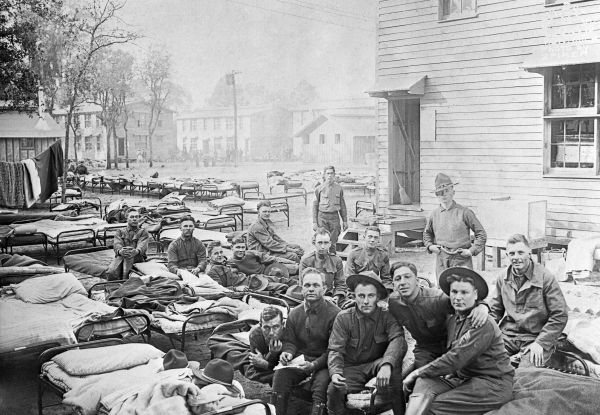
floridamemory.com/items/show/141993
Forensic historians now believe that
the cases of flu seen at that Kansas Army post were the first instances
of this influenza recorded anywhere in the world.
Although parallel paths of contagion may have existed, the
progress of the disease across the
U.S.
can be tracked accurately by following it through the military.
It went from one Army post to another, and from Navy ship to
another, spreading to civilians in nearby communities and ports.
Navy ships' visits to other nations coincided with the first
influenza outbreaks in the South Pacific and
Asia
. American troop ships seem
to have brought this influenza to
England
and
France
, whence it spread across Europe (even to
Germany
, via French prisoners-of-war).
*
The
"Spanish" Influenza
Washington
forbade American newspapers from reporting on the epidemic, so as not to
panic the public (who, of course, already knew that all the funeral
parlors for miles around had literally run out of caskets).
Other combatant countries did the same.
But in neutral
Spain
the press remained free, and it wrote about the country's horrible
experiences with the deadly flu. As
reports from
Madrid
got translated and distributed in other countries, the disease that had
appeared in reality first in
Kansas
, but in print first in
Spain
, came to be known as "The Spanish Influenza."
One cannot really tell from death records how many people died.
This influenza typically evolved into fatal pneumonia or
meningitis, so that officials often named those diseases on death
certificates, rather than citing influenza itself.
Statistics sometimes make the magnitude of the toll clear.
In
Philadelphia
, for example, in the depths of the epidemic, each day's death figure
exceeded the city's normal weekly total.
It now is believed that during the pandemic about 5%
of the world's population died from influenza.
***
Rest
In Peace, At Least for Now
Five weeks after leaving
Camp
Upton
for further training in
Jacksonville
, Walter Wheeler was assigned to the 417th Motor Supply
Train. By August 22nd
he had been promoted to Corporal, and his unit boarded SS
Lutetia, bound for
France
. Most likely, the voyage
actually ended in
England
, where the troops marched to a second ship, which crossed the
English Channel
. They set foot in
France
on September 5th. Once
the men and equipment had re-grouped, the 417th was ready for
the Front, and the Supply Train headed for the
Argonne
Forest
.
On September 26th,
the war-changing Meuse-Argonne Offensive began, and the 417th
was in the thick of the fray - but Cpl. Walter S. Wheeler was not.
On that day, only three weeks after his unit had set foot in
France
, he died of bronchial pneumonia.
*
To
do its part in sustaining the Offensive, the 107th Ammunition
Train worked around-the-clock, supplying not only "its own" 32nd
Division, but also whichever troops were closest and most in need of
ammunition. The weapons fire
was intense. As the German
troops slowly retreated, an additional threat was revealed.
Enemy machine-gun nests remained hidden in the forest, quiet;
they opened fire only as the advancing Americans passed by.
Just how and when Pvt. Charles A. Wagner was wounded I do not know, but
he died of wounds on October 2nd.
Obviously, Wagner and the other men in the Trains understood
their extreme peril, but they found the resolve and courage to do their
jobs nonetheless.
*
Joseph Barry left Camp Joseph E. Johnston about
three weeks before Walter Wheeler, as part of the 416th
Motor Supply Train. On July
31st he sailed from Newport News, Virginia on
SS Tenadores. A month
later, he was promoted to Corporal, and soon after that to Sergeant.
Judging by where in France the dead of his unit were later
buried, the 416th also must have seen action during the
Meuse-Argonne advance.
On November 3, 1918, a mere eight days before the Armistice, Sgt.
Barry died of meningitis.
***
Remembering the Fallen
The
American Legion was established in France, in 1919.
When the Hicksville Post was formed not long afterwards, it was
named after Charles A. Wagner.
*

Huntington Long-Islander, January 24, 1919
Hicksville
began planning its war memorial only weeks after the war's end, but
before long the effort became contentious.
Who would build the
memorial? Whose names would
it bear? Who had authority
to make such decisions?
Less than a year earlier, the "Tail Light Riot" (see 1901/Hixtory.htm
) had laid bare a rift between the village's leading citizens - in
any disagreement, some looked to Justice Joseph Steinert for guidance,
but others looked to Dr. Elwood Curtis.
This rift again now came into play again with regard to the
memorial. An ad hoc group
had started planning a soldiers' homecoming celebration and the war
memorial. Within months,
snarky letters about the group's infighting appeared in the Long-Islander,
the group's original leaders were ousted, the contractor selected to
build the monument was replaced, the once-independent group became part
of The Patriotic Sons of America,
and Dr. Curtis was named the revamped group's leader.
Despite the rather shameful discord and strife, Hicksville got its
monument in time for a grand July 4, 1919 dedication ceremony at Depot
Square (aka The Triangle).
*
On
January 20, 1924, a Knights of Columbus Council was formed at St.
Ignatius parish. Its
founders named the Council after Joseph A. Barry, in consideration of
his having been "a young man of the highest character."
***
Graves

Sommerance Ridge Cemetery, Sommerance, France
History of the 328th Regiment of Infantry
During
the war, American soldiers who died in service typically were buried as
soon as possible, often in makeshift cemeteries near where they fell,
such as this one (shown in the snows of the first post-war winter).
After the war's end, the soldiers' remains usually were given
proper burials in permanent cemeteries.
*
How Many Times Should A Man Be
Buried?
Americans
felt two ways about where the war dead were buried.
Some longed to be near the graves of their children or spouses,
and thus wanted them to be buried in hometown cemeteries, close to their
families. Many people,
perhaps most (and certainly the Federal government), believed instead
that it was more appropriate for those who died in France to remain
there. But in actuality, the
dead would not be allowed to lie where they were.
The American Battlefield Monument Commission was building a
number of American Cemeteries in France, to which the remains of the
nation's war dead all would be moved for yet another burial.
Despite this fact, the Commission argued publicly that to exhume
a loved one's remains in order to send them home for reburial would be
cruel.
A compromise was reached: families were given until 1923 to decide
whether or not the remains of loved ones should be repatriated at
government expense. For
families that so wished, the remains were disinterred, disinfected, and
placed in simple wooden coffins, which were enclosed by sturdy
purpose-built shipping crates. The
crates, draped with flags, were loaded into boxcars or canal boats, to
the outside of which large American flags were affixed.
The trains and convoys of boats were blessed by French priests,
and then traveled to ports. The
vessels onto which the remains were loaded all arrived in Hoboken.
From there, the remains were sent across the country by rail, to
the hometowns of the soldiers' waiting families.
*
A Quiet Journey Home
In
the spring of 1921, Walter Wheeler and Charles Wagner were disinterred,
and together their coffins were sent back across the Atlantic.
They arrived at the Hicksville railroad station several days
before Memorial Day. As was
customary, the coffins were taken to the homes of the soldiers'
respective parents.
On the following Saturday, Cpl. Wheeler was buried at Plainlawn.
The pallbearers were members of his old Fire Department unit, the
Volunteer Engine and Hose Company.
The next day, Pvt. Wagner was buried at St. Brigid's in
Westbury. Each man was
buried with full military honors, with the Charles
A. Wagner American Legion Post attending and firing a salute.
|
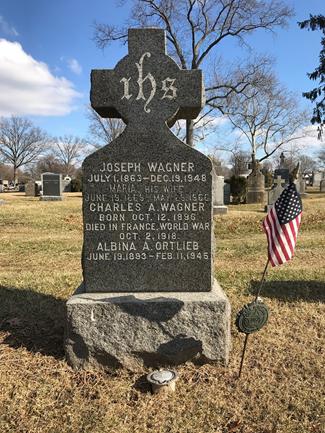
|
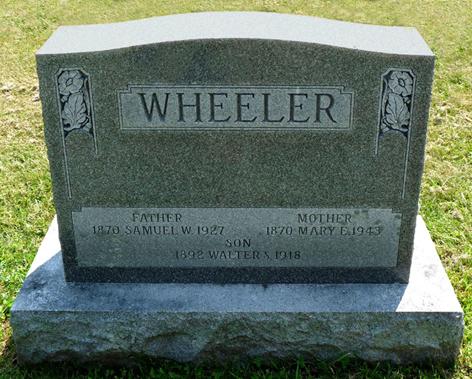
|
|
Wagner
family plot in St. Brigid's Cemetery
Find-A-Grave.com
|
Wheeler
family plot in Plainlawn Cemetery
Find-A-Grave.com
|
*
A Quiet Journey Abroad
The repatriation matter may have been
settled by 1923, but the mourning did not go away.
Thanks to the efforts of the Gold Star Mothers organization (see 1806/hixtory.htm
) in 1929 the
government polled mothers and widows about their interest in making
"pilgrimages" to the graves in which their children and husbands
were buried. From 1930 to
1933, many of these women were able to travel in escorted groups to
France, at public expense.
Joseph Barry's remains are buried at Suresnes American Cemetery,
less than four miles from the Eiffel Tower.
Fifteen hundred other doughboys are buried in the same cemetery,
including two other members of the 416th Motor Supply Train
(one of whom, like Barry, died of meningitis).
Unlike Maria Wagner and Mary Wheeler, Ellen Barry could not take
comfort in knowing that she and her son would someday be buried in the
same family plot. But like
them, Mrs. Barry had her chance - although only too briefly - to
stand peacefully beside the grave of a first-born son while she prayed
and pondered.
†
† †
Sources
In addition to sources noted in the
photo credits, the following were consulted:
|
Ancestry.com
|
|
■
|
United
States Army Transport Service, Lists of Passengers (re soldiers
departing from Hoboken, New Jersey)
|
|
■
|
Various
Federal and New York State Censuses
|
|
■
|
World War I Draft
Registrations
|
|
■
|
Abstracts
of New York residents' military service
|
|
■
|
Family
Tree and related items posted by C.E.B. Howard
|
|
Huntington
Long-Islander
|
|
|
numerous articles re the
soldiers, their families, and the Hicksville War Memorial
|
|
Through the War with Our Outfit, Being A Historical Narrative of the 107th
Ammunition Train
|
|
|
John C. Acker
|
|
The Great Influenza; The Story of the Deadliest Pandemic in History
(2018 edition)
|
|
|
John M. Barry
|
|
U.S. Army Medical Department, Office of Medical History, Chapter 11 (Meningococcal
Meningitis)
|
|
|
John J. Phair, MD
|
|
The 314th Supply Train in the Great War
|
|
|
Milton E. Bernet
|
|
American
Battle Monuments Commission website
|
|
|
https://www.abmc.gov/
|
|
History
of the Three Hundred and Twenty Eighth Regiment of Infantry, 82nd
Division, American Expeditionary Forces
|
|
|
Historical Committee of
the 328th Infantry
|
|
Military
Operations of the American Expeditionary Forces
|
|
|
Center of Military
History, United States Army
|
***
This Memorial Day,
Please Wear a Poppy and Remember
|




















